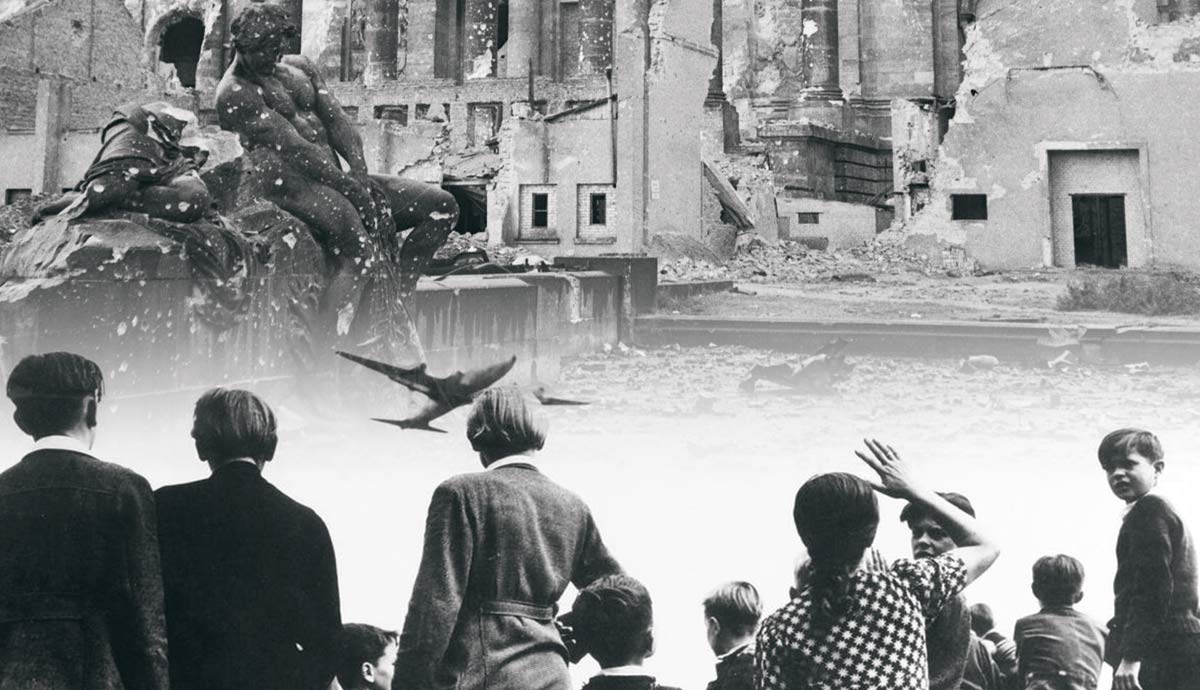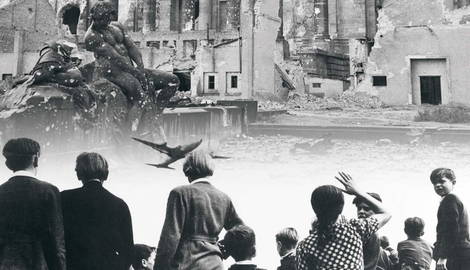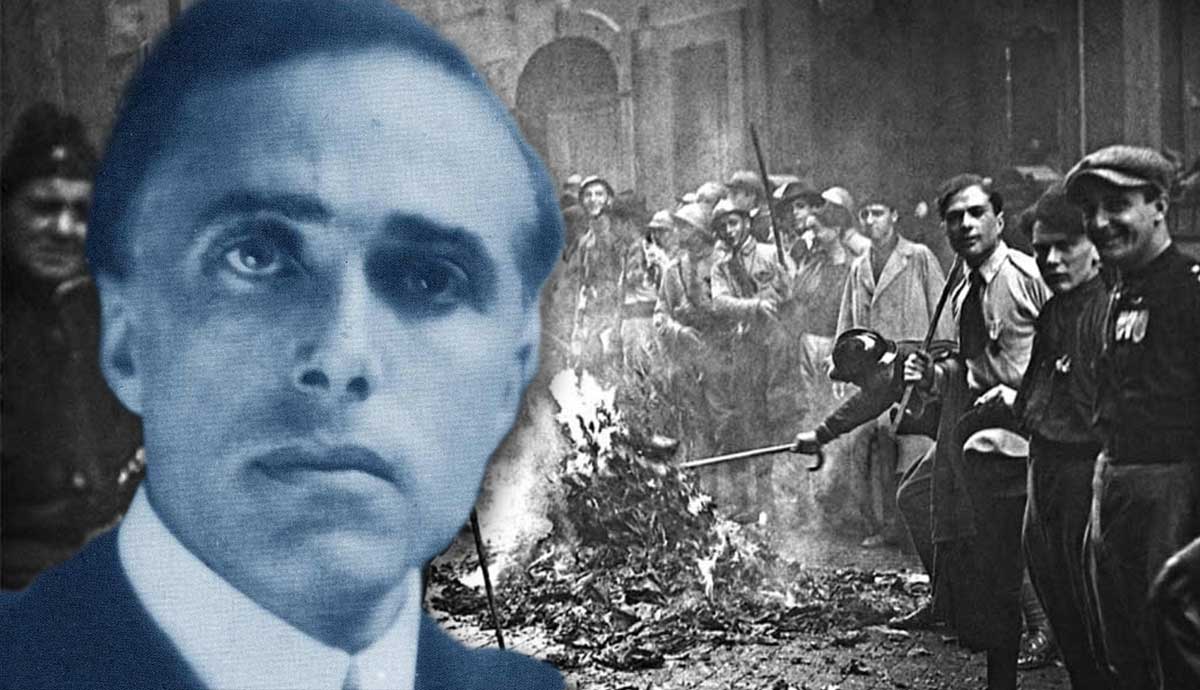
“People of the world,” pleaded Ernst Reutuer, the future mayor of West Berlin, on September 9, 1948, “…. look upon this city! You cannot, you must not, forsake us!” When Reuter made his famous appeal, the West Berliners had already been struggling for months under the Berlin Blockade, implemented by Soviet authorities to force the Western powers to withdraw from the city. The humanitarian mission known as the Berlin Airlift would be the only source of vital supplies for more than two million people until May 12, 1949, when the Soviet Union lifted the blockade. The Berlin Airlift was the first confrontation between the Western and Eastern blocs. It played a crucial role in the Cold War and its future development.
Uneasy Postwar Relations: The Road to the Berlin Airlift

Following the end of World War II, the alliance between the Soviet Union and the Western powers—the United States, Great Britain, and France—quickly deteriorated. “From Stettin in the Baltic, to Trieste in the Adriatic,” declared Winston Churchill in his March 1946 speech, “an iron curtain has descended across the continent.” Amid growing tensions, the fate of the defeated Germany was a crucial point of contention among the wartime allies.
Immediately after the end of the hostilities, the Allies had divided the territory of the former Nazi regime into four occupation zones. Though the city of Berlin was in the Soviet-controlled area, it had also been divided among the victorious powers. Each zone was administered by a military government. Each of these governments, led by the commanders of the armed forces, was responsible for policymaking in its respective zone. At the same time, the commanders regularly met in the Allied Control Council to coordinate joint control over Germany as a whole. Similarly, the area of Greater Berlin was governed by an inter-Allied body known as Kommandatura.

At the Potsdam Conference in 1945, the leaders of the victorious countries confirmed the postwar division of Germany into four occupation zones. However, they failed to reach a permanent agreement on the so-called “German question.” As the relationship between the Western powers and the Soviet Union became more strained, the fragmentation of the defeated former Nazi Reich became the physical emblem of a polarized world order, where two opposing blocs, each representing contrasting political and economic systems, battled to expand their “sphere of influence.”
The Berlin Crisis

In 1947, tensions between the Western Allies and the Soviet Union concerning the shared policy-making in Germany started to rise. In January, the United States and Great Britain united their occupation zones in Bizonia. The decision caused unease within the Soviet Union; its leadership felt threatened by a unified Western bloc near their zone.
The relations between the wartime allies worsened in March when US President Harry S. Truman announced that “it must be the policy of the United States to support free peoples who are resisting attempted subjugation by armed minorities or by outside pressures. If we falter in our leadership, we may endanger the peace of the world—and we shall surely endanger the welfare of our own nation.” Truman’s speech, which inaugurated a new direction in US foreign policy known as the Truman Doctrine, worried the Soviets and further cemented the divisions of the postwar international order.
The strain between the Western and Eastern blocs had already reached a critical point during the Conference of Foreign Ministers in Moscow. The collapse of the summit permanently put an end to the wartime alliance between the powers that defeated Adolf Hitler. The situation worsened in June when US Secretary of State George Marshall presented his plan for the economic recovery of postwar Europe. The so-called Marshall Plan also aimed to draw the continent into the United States’ sphere of influence.

Tensions between the Soviet Union and the Western powers were approaching a full-blown crisis in March 1948 when the Soviets withdrew from the Allied Control Council to protest the other occupational forces’ intention to unite their zones, a move they claimed violated the Potsdam Agreement. In June, the Western Allies introduced a new currency, the Deutsche Mark, in the western part of Germany and West Berlin, with the double aim of stabilizing the country’s economy and challenging the Soviet authorities’ influence on the city. Soviet authorities, fearing that West Berlin would become a “bridgehead” for the opposing bloc to insert its presence in the middle of their occupation zone, responded with the introduction of a competing currency, the Ostmark, and the so-called Berlin Blockade.
On June 24, 1948, the Soviets interrupted the rail traffic between West Berlin and the rest of Germany on the Berlin-Hannover live. They also proceeded to block all highways, railroads, and canals, effectively cutting off the western sectors of the city. The Soviet representative also withdrew from the inter-Allied Kommandatura.
The Berlin Blockade

The main goal of the Soviets’ Berlin Blockade was to draw the Western powers out of Berlin. In 1947, before the Conference of Foreign Ministers, Fedor T. Gusev, deputy foreign minister of the Soviet Union, had already hinted at this scenario: “If the English and Americans refuse to make concessions to the Soviet Union’s entirely legitimate demands…the Soviet Union may be forced to consider eliminating the zone of Greater Berlin and integrating the entire territory of Berlin into the Soviet zone.”
When Soviet authorities implemented their Berlin Blockade, the more than 2 million residents of the city were still reeling from the effects of the Nazi regime’s military collapse. As the scenes from Italian filmmaker Roberto Rossellini’s movie Germany, Year Zero show, the city lay in ruins after heavy Allied bombings. Finding shelter was often difficult as the streets were full of rubble. The black market was the main source of food, and the threat of starvation constantly loomed for most Berliners.

The same day the Soviet Union began the Berlin Blockade, the Social Democrats, led by Ernst Reuter, organized a rally to protest against it. Referring to the February 1948 Communist coup in Czechoslovakia, Reuter declared: “Berlin will not be next! We will use all means at our disposal to fight against the claim to power that will turn us into slaves…We have already lived under this type of slavery in Adolf Hitler’s Reich. We have had enough of it. We refuse to go back!”
While Reuter’s speech turned the Berlin Blockade into an open confrontation between the two postwar “superpowers,” the Soviet Union did not doubt the effectiveness of its extreme measure. Indeed, in 1948, the USSR’s military presence in the city was considerably bigger than that of its Western counterparts. The US military command in Germany was similarly aware that, should an armed conflict break out, the United States would face a quick defeat. The only way to break through the Berlin Blockade was by flying in supplies to the West Berliners.
The Candy Bombers

In the immediate days after the Berlin Blockade, the US government quickly became aware that the event would play a crucial role in its relationship with the USSR. Robert Murphy, the advisor on German affairs, remarked that remaining in western Berlin would be “a symbol of resistance to eastern expansionism. It is unquestionably an index of our prestige in central and eastern Europe.” Even before the Berlin Blockade, when a crisis seemed imminent, General Lucius Clay, the American Military Governor in Germany, had shared the same opinion: “There is no practicability in maintaining our position in Berlin and it must not be evaluated on that basis…We are convinced that our remaining in Berlin…has become a symbol of the American intent.” US President Harry Truman echoed Clay’s sentiment: “We are going to stay—period.”

When the former wartime allies divided Germany and Berlin into occupation zones, the Allies’ right to access Berlin had never been formally recognized. However, the postwar written agreements had left air corridors connecting the city to the rest of Germany open. And so, on June 26, 1948, with “Operation Vittles,” the United States began flying food and other vital supplies to the city. Two days later, Great Britain also joined the so-called Berlin Airlift.
Initially, the airlift, known in Berlin as Luftbrücke (air bridge), seemed an almost impossible endeavor, especially after it became clear that the Soviet Union did not intend to lift its blockade in the foreseeable future. On the contrary, the Soviet authorities, hoping to weaken West Berliners’ resolve to support the airlift, offered ration cards to those willing to transfer to their sector. However, only about 20,000 people accepted the offer.

The Berlin Blockade and subsequent Airlift led to political turmoil in Berlin, as the Socialist Unity Party of Germany (SED) and the Western parties battled to implement their opposing views concerning the future of the city. While the eastern leader Walter Ulbricht attributed the responsibility for the internal divisions to “the reactionary forces in the West,” Reuter repeatedly asserted West Berliners’ will to support the Airlift: “We will return to the Eastern sector of Berlin, and we will return to the Eastern zone of Germany!”
As the blockade continued, the American and British pilots perfected the timing of their operation. At one point, one Allied flight landed at Tempelhof, Gatow, and Tegel airports every minute and around 8,000 tons of supplies arrived daily in Berlin. In total during the Berlin Airlift, the Western powers delivered more than 2.3 million tons of vital resources, including fuel and machinery.
In West Berlin, the Allied pilots were commonly known as Rosinenbomber (candy bombers). The nickname started when Lt. Gail Halvorsen, a US pilot, decided to throw chocolates and other candies from his plane to the younger residents of Berlin. Soon, his colleagues began doing the same. As Halvorsen usually jiggled his airplane to announce the special drops, the children affectionately began calling him “Uncle Wiggly Wings.”
The End of the Blockade

As the airlift continued, it became clear that the Western powers would not withdraw from their sectors of Berlin. On the contrary, the crisis led to the political division between the western and eastern zones of the city. Toward the end of 1948, only the residents of West Berlin took part in the elections for the City Council. In October, the Soviet authorities and the SED introduced stricter control measures at the crossing points along the sectors’ borders. With the so-called “ring around Berlin,” the Soviets erected a series of checkpoints and started surveilling the motor traffic between the zones. However, the residents were still free to cross between sectors.
While the United States and its allies demonstrated their willingness to sustain the struggle of West Berliners indefinitely, the Soviet Union’s resolve to continue the blockade began to weaken as the effects of the trade embargo against its occupation zone exhausted its resources. In particular, the counter-blockade deprived the Soviet-controlled areas of the coal delivered from the Ruhr Valley.
Fearing political upheaval, on May 12, 1949, the USSR finally lifted the blockade of West Berlin. By then, the US pilots had made about 260,000 flights to the city’s airports. The Berlin Airlift continued until September 1949, as the Allies wanted to be prepared in case the Soviets implemented another blockade.
The Aftermath of the Berlin Airlift

The first Berlin Crisis and the blockade and airlift that followed accelerated the process that led to the creation of two separate German states. About ten days after the end of the Berlin Blockade, the Federal Republic of Germany was created out of the western Allied-controlled sectors. In October, the Soviets founded the German Democratic Republic (GDR) in their occupation zone. East Berlin became the capital of the newly founded state. The 1948-1949 incident also had crucial international repercussions, foreshadowing the bipolar world order that would last until the end of the Cold War. Before the end of the Berlin Airlift, the Western bloc established the North Atlantic Treaty Organization (NATO), a military alliance to act as a counterweight to the Soviet armed forces in Eastern Europe.
In Berlin, and West Germany, the airlift laid the foundations for a strong relationship between the United States and the Federal Republic of Germany. Lt. Gail Halvorsen remarked that the blockade “turned enemies into friends.” The West Berliners’ opposition to the inclusion of their sectors in the Soviet zone transformed the city into an international symbol of the struggle between democracy and the oppressive regime of the USSR.
While the end of the blockade thwarted the Soviet Union’s plan to expand its influence, tensions in Berlin remained high. In 1961, when a second Berlin Crisis broke out, the Soviets erected the Berlin Wall to seal off their sector.











